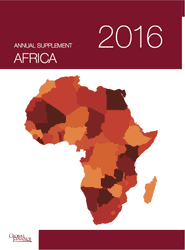African nations, facing low prices for many of their exports, strive to build strong economies for the long term.
Back To Supplement
What has changed in Africa in the past year? The precipitous drop in commodity prices in 2015–2016, alongside the economic slowdown around the world

The pressure has abated somewhat with a subdued bounce-back in raw materials prices. “The general rise in commodity prices have provided some respite for African markets,” says Goolam Ballim, chief economist and head of research of Standard Bank. “At the minimum, African resource economies have been able to reverse some of the earlier negative terms-of-trade shocks.”(especially among its Asian investment partners), threatened the progress made during two decades of tremendous growth on the continent.
But that’s not the only positive development of 2016. Melissa Cook, founder and managing director of African Sunrise Partners and a member of President Obama’s Advisory Council on Doing Business in Africa, cites three: growing power generation capacity, especially in thermal and renewable sources; commercialization of agriculture; and technology delivering concrete benefits.
“Agriculture as a business is starting to be a significant trend, leading to improved farm incomes and better food self-sufficiency,” she observes. “Technology and communications are starting to affect many industries for the good—banking, healthcare, education, commerce and politics. This is an unstoppable trend,” she adds.
Yes, the commodity hangover is painful, creating severe currency shortages in oil-exporting countries. However, “much of the pain is self-inflicted because of policy mistakes,” Cook notes. “Too many heads of state change the constitution to allow longer terms, or ignore election results, which leads to violent protests and a halt to economic activity.” Ballim believes the weather is a more significant factor, with El Niño producing drought in Southern Africa and soaking the eastern parts, as well as cutting into hydroelectric power production in several countries.
Hard infrastructure—power stations, bridges, dams and airports—isn’t the issue it once was. “A lot of smart people are working on figuring out how to make infrastructure [projects] happen. This is the easy part,” says Cook. “The hard part is soft infrastructure—education and human capital—which will support innovation, allow for efficient operations of the hard infrastructure being built, and drive diversification and economic complexity for sustained wealth creation and widespread prosperity.”
Our supplement looks at the issues African nations face in developing their economies today, including banking innovation and tax harmonization. We also present our annual list of the continent’s best-performing exchange-listed companies. Recently a McKinsey Global Institute study found that large companies in Africa are growing faster than their peers elsewhere. In a low-growth world, that’s something to celebrate.



